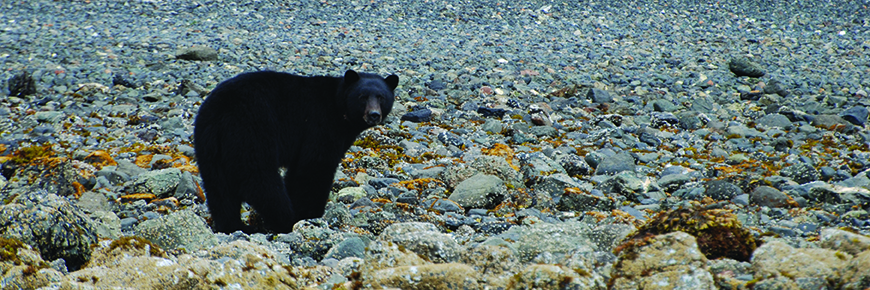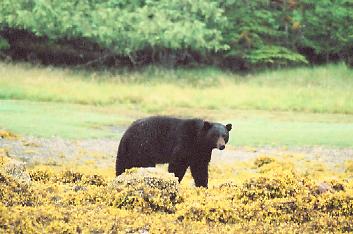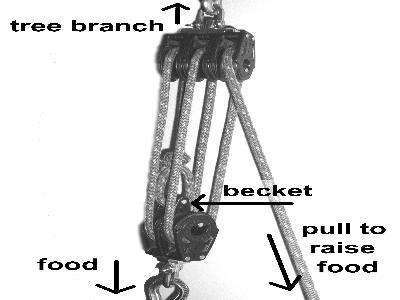
Bear aware food caching
Gwaii Haanas National Park Reserve, National Marine Conservation Area Reserve, and Haida Heritage Site
Respecting Taan: How to Hang your Food
Taan, black bears, live throughout Gwaii Haanas and are an important part of our island ecosystem. However, bears that learn to associate humans with food lose their natural fear of people. This can lead to potentially deadly encounters. It is your responsibility to properly store your food, dishes, garbage, and toiletries while in Gwaii Haanas. Not sure how to hang your food? This short video will walk you through the steps.
Additional resources:
Bear-resistant storage products
Note: Taan, black bear, are common in Gwaii Haanas. We do not have Grizzly bears, wolves or cougars on Haida Gwaii.
A longer version of this article was written by Gord Pincock of Butterfly Tours.
To hang or not?
It's a gamble to leave any food accessible to animals overnight. Yet, when facing a huge and heavy pile of food at the end of a long day, the effort may appear to outweigh the risk; it can be tempting to leave some, or all, of the food un-cached. If a bear gets a few bits and pieces of food, it may not pose a great hardship to your group. What's the problem if a bear gets a few morsels, especially if most of the food is safely cached?

The problems may only arise for future campers in the area. After sampling campers' food, bears will begin to recognize campsites as sources of interesting and easy meals. Bears then become habituated; they remember what our campsites smell like and they recall how effortless it is to walk in and help themselves to our food. Cubs inherit this feeding technique and the problems compound.
What about canned-goods and tetra-pacs? Many campers believe that these items are not attractive to bears because very little scent is transmitted through the packaging. It often feels tempting to leave these heavy items out of the cache. While I've never experienced a bear tearing into cans or tetra-pacs to lick out the contents, I've heard credible reports that bears are certainly interested and willing to do this! To avoid habituating bears, it's best to hang all the food.
Persuasive reasons
For food caching to work, the entire group must be informed (and sometimes persuaded) of the plan. Groups I've camped with become convinced and very helpful after hearing the risks and how to effectively manage them.
There are many excellent reasons to hang food while camping in Gwaii Haanas. I sleep much better when my camp is secured against animals, high tide and weather. A sound sleep is reason enough for me to hang the food, yet I provide my guests with further motivations… Parks Canada may permanently close campsites if bears in the region become habituated. Nobody wants to be responsible for a campsite becoming closed to all future campers.
Guests are likely to continue practicing what they learn on guided tours. Guests observe guides and may consider that if a guide does it, then it's ok for them to do it too. If I do not cache food during a guided tour in bear country, my guests may not feel inclined to cache food during future trips, which could cause bears in other regions to become habituated. In many places, it's common for habituated bears to be destroyed. I prefer to cache all my food so my guests have the opportunity to learn the technique and bears elsewhere may avoid the untimely fate of becoming habituated.
In order to convince my guests never to take any food into their tents, I describe how a bear could shred the tent fabric and walk right over them to investigate a few crumbs, a flavoured drink or even a candy wrapper in the pocket of their trousers! Bears are curious opportunists with an incredibly perceptive sense of smell; they don't need to see food in order to become interested.
Similarly, storing food in kayaks is not a good idea. Bears will smell the food and it would take little effort for them to rip a hatch or cockpit completely off in order to access the meal inside. After opening a kayak and eating, a bear and its' offspring may begin associating kayaks with food; they may continue opening kayaks whenever the opportunity presents itself.
To convince my guests even further, I mention that if an animal damages a tent or kayak because food was left in it, the person responsible would be requested to purchase the damaged equipment so that it could be replaced with new gear. (Sometimes the most potent and memorable motivations exist in our own pocketbooks!)
What about daytrips?
Daytrips are popular activities during kayak tours. Oftentimes, we leave our tents up and go paddling for several hours, returning to camp later in the day. I'm convinced that the most likely time for a bear to wander through my camp is when no one is there. When we leave camp, we take much of our food with us; it makes great ballast and can serve as emergency-rations. We hang any food that is left behind. We're also sure to check that no other potentially interesting items are left at camp; bears may be curious about things like insect repellent, sunscreen or toothpaste. In fact, bears may be inclined to investigate just about anything that smells out of the ordinary!
Almost every kayak trip will involve landing on beaches, having lunch and going for walks through the forest. Since bears forage along the intertidal zone, leaving fully loaded kayaks on a beach is like leaving bait in the path of hungry bears. When we go for short walks in the forest while our loaded kayaks remain on the beach, we typically leave one guide with the boats while the other guide accompanies the guests on the walk. The two guides can remain in contact via radio. For longer walks, we'll unload the kayaks and hang all the food so that both guides can join the hike.
The pulley system
When it's time to hang the food, a pulley system makes the task much easier. After experimenting with several varieties of pulleys, I've settled on a pair of high-quality pulleys designed for sailing; they withstand the salt-water environment without corroding. I prefer pulleys that are intended for holding over one hundred kilograms on a continuous basis. (Many pulleys are designed for lighter loads, or for holding momentary loads; heavy overnight loads would flatten their bearings.) The top block has three pulleys; the bottom has two pulleys plus a becket (a loop to fasten the end of the rope).

I carry two lengths of strong rope. I prefer 7mm or 8mm static climbing rope because of its excellent handling qualities plus its great strength to weight ratio. One rope is about 20 meters long, the other about 30 meters.
I select a tree and chose the branch... There are lots of theories on what makes an appropriate food-caching branch. I simply visualize my food hanging from a particular branch, then I imagine myself as a hungry bear. Obviously, the food must be high enough to be beyond reach. It also must be far enough away from the tree's trunk and branches so that it would not be accessible to a climbing bear.
Pick a strong branch
To get the shorter 20-meter rope over a tree branch, I tie a very small stuff sac to one end, fill it with gravel and toss it over an appropriate limb. (Since my aim is not always perfect, I tend to do this when all the guests are setting up their tents elsewhere.) My first few shots may go over the wrong branch. In order to avoid snags, I've learned that it's best to pull the bare rope back over the undesired limb, rather than pulling the stuff sac over. Once the rope is over the correct branch, I carefully test the strength of the branch; will it hold all my food for the entire night?
All the food is placed into duffel bags, or into a cargo net. The top block (with three pulleys) is tied to one end of the 20-meter rope; the bottom block is tied to the food. My preferred knot for these applications is the bowline; it ties quickly, holds well and will untie swiftly even after holding heavy loads for long periods.
Thread the longer 30-meter rope back and forth through all the pulleys on both blocks, fastening one end to the becket on the bottom block. Now, pull the 20-meter rope to raise the top block to the desired height and fasten the 20-meter rope securely. By pulling on the loose end of the 30-meter rope, you can raise a heavy pile of food with relatively little effort.
Food hammocks work too
Large groups on long trips may require two or more pulley systems. I've heard of groups who hauled up large cargo nets by using a pulley system on each end of the net, creating large “food hammocks.”
After lowering the food the next morning, it's often best to remove the blocks from the rope. The pulleys tend to twist the rope, so it can become terribly snarled if it's simply packed away without removing the blocks first. After the blocks are off, I grab the centre of the long rope and walk down the beach, allowing the rope to untwist. If sand gets onto the rope, I dip it in the sea to clean it. (Sand in the pulley's bearings will wear them out fast.)
Outfitters may want to double-check that each of their tours are properly equipped for food hanging and that their guides understand the importance of consistently completing the task.
Independent kayakers may want to practice their food hanging techniques before a trip to become familiar with how their pulley system works. It's best to be confident that you're launching with proper equipment.
If we all practice appropriate bear caching habits, it's likely that we'll continue to encounter very few “problem bears” and no additional campsite closures in Gwaii Haanas.
Every summer since 1981, Gord Pincock has kayaked throughout the Queen Charlotte Islands. His company Butterfly Tours provides guided sea kayak expeditions in Gwaii Haanas. Gord also runs certified kayak leadership courses through Evolution Guide School is a director of the Gwaii Haanas Tour Operators Association.
- Date modified :